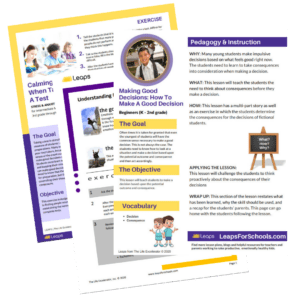Leaps is different because it is born out of psychosocial remediation training.
We are sometimes called an SEL provider, and in some respects, we do provide social emotional learning opportunities. But, unlike other programs that are focused on SEL, Leaps was initially developed to help people, adults and children, who were moving from institutions into the community and they needed to increase their social intelligence and their emotional intelligence. Many of these individuals were very bright intellectually but they lacked the adaptive or emotive skills to fit into society. They were taught systematically how to grow their social capacity while simultaneously increase their emotional intelligence so that they could integrate into a more independent societal setting. Great success was achieved!
In fact, we have been able to prove out the efficacy of Leaps’ behavior supports and academic impact enough that we offer a guarantee to schools that put the Leaps program in place. If you have Leaps, you don’t need an SEL program. You’ll get that and so much more.Â
Fast forward to today, after decades of research, adaptation, and application Leaps has taken the clinical process of deficit assessment and addressment within the scope of social capacity and emotional intelligence and used it to create individual scope plans to increase learning capacity thereby increasing the student’s ability to learn. In other words, Leaps has taken the clinical and made it classroom ready for the educators. Assess your student, lessons are recommended to address the assessed deficits, progress is measured, targets are given, success is achieved.
The wonderful thing about increasing a student’s social and emotional learning capacity is that when the student learns to sit in class and pay attention and get along with other students and the teacher and feel better about himself and understand the stresses and expectations of being a student – learning can occur – all learning. Leaps is Social and Emotional Learning.
To grasp how different Leaps is from other SEL programs, it is first important to fully understand social emotional learning (SEL) and having healthy expectations that match the depth and scope of the impact of good SEL on the learning and social context and assimilation of students.Â
Let’s start with the S in SEL
The Because social skills, as a process, are such a known commodity in the educational lexicon, it would be easy to think that the S in SEL is simply referring to social skills but it refers to so much more. Social skills are often referred to as “soft skills”. This label is not mean to deride the importance of social skills but instead it refers to the individual malleability of each skill and the difficulty of truly differentiating each level of functioning for these skills.
Social skills, when presented in a set order, tend to come in a “one size fits all” program approach and this is where Leaps truly differentiates itself from other programs, where it is a true SEL initiative. Social capacity increases when the individual student’s social quotient, relevant age and intelligence, increases.
Leaps purposefully increases social capacity by assessing, understanding and addressing social deficits and strengths. By knowing the deficits and increasing capacity within assessed deficit areas while augmenting strengths the individual student’s social quotient – or maturation and age equivalency – increases. By purposefully increasing assessed deficit areas, thereby increasing measured capacity, the student’s social quotient increases.Â
Leaps is maturing the student by assessing and addressing the areas of need within a social quotient context.
So how does this make Leaps different?
Think of it like this – Intelligence is a measure of functionality. Years ago, intelligence was a more literal measurement of ability to intellectualize information. But in recent years, it has been understood that intelligence is a much more socialized process. Pure intellect without the ability to adaptively use it in social settings is not truly functional. In fact, intelligence is measured within the terms of Intelligence Quotient and Social Quotient. These are the two factors that create the intelligence formula.
It is known that Social Quotient or maturation directly impacts a student’s ability to succeed in the classroom or with friends or even at home. So as Leaps increases a student’s social abilities and increases a student’s social quotient it actually increases the student’s overall ability to intellectualize the quotient skills that cross those malleability lines such as problem solving and understanding consequences. This is achieved through the chaining of deficit based skills within the scope of the prescriptive plan that Leaps provides to address the deficits. Individual skills are learned but overarching maturation skills begin to foment that mature the student to targeted age equivalency targets. This is known as the psychosocial remediation.
In other words, the specific skills that are taught to ameliorate assessed deficits do so in an ordered manner which in turn helps the student to socially mature at an appropriate age equivalency rate which then makes the process of classroom learning and social setting interaction more attainable. As the student learns the Leaps skills that are targeting the student’s assessed deficits, the student is becoming more socially adept which is giving the student the skills to be a better classroom learner and a more socially amenable option to his or her peers. He is a better student and a better friend so he has a better chance to learn and a better change to be socially accepted.
Why does that matter?
When social skills are presented in a non-directive fashion then targeting results is difficult because there isn’t a true starting point for the training. Leaps takes a very different approach because it gives the teacher multiple mechanisms to determine the best skills to teach. Leaps makes available “Classroom Challenges†which is a group observational assessments which allow the teacher to make behavioral observations of the class and Leaps then prioritizes, within the selected skill set, the lessons most necessary in a priority order for the class.
Leaps also has multiple versions of individual assessments that will fit the needs of the students. These assessments will provide a full profile of the student with concomitant teaching and training strategies. Leaps also has a triage form assessment that will provide a benchmark functionality determination along with next step recommendations. Leaps takes the breadth of social skills and makes the scope manageable through planned teaching in formats driven by informational data through multi-platformed assessment options.
The E in SEL is also a critical component of growth for any student.
Emotional growth and emotional intelligence represents the ability to identify and understand and manage and communicate effectively the feelings that come to the student often or sporadically. So how is Leaps different in addressing the E? This one is tricky. Emotions aren’t clearly discernible. The end product of emotions are discernible but the actual emotion itself is not. A frown or a tear or a smile or an outburst is easily seen but what is happening inside the student’s mind is known only to that student. So what do we do and how do we do it differently?
Leaps approaches emotions as part of the continuum of the psychosocial process. This means that neither emotions nor social capacity nor intelligence nor physical influencers exist in a vacuum. Instead, emotional skills training is approached with the same logic and clinical fervor precision as social capacity training. The student is assessed for emotional skills strengths and deficits. When the deficits are identified they are addressed in a priority order with a learning process that teaches the skills necessary to not only learn the skill but to practice it within a contextualized setting so that the student can assimilate the skill. Emotional intelligence is the ability to understand that emotions can be controlled but at the same time respected and understood.

 Â
Â